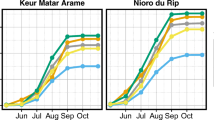Abstract
The management of high-quality timber plantations prioritizes obtaining high productions with short rotation cycles, which results in high economic and environmental costs, similar to intensive agricultural systems. The suppression of the herbaceous understorey by ploughing, and the use of fertilizers to boost tree growth potentially pose high environmental risks. Managing these plantations as silvopastoral systems (e.g. by introducing livestock and sowing legume-rich pastures) could reduce environmental risks. However, this management shift can only be effective if it is accompanied by an increased complementarity in the use of soil resources to maintain production. We evaluated rooting systems, tree water status and growth, pasture production, soil moisture and nitrate content in the soil solution in a 13-year-old hybrid walnut (Juglans major × regia) plantation under alternative management schemes. The management aimed at reducing herbaceous understorey cover (grazing, ploughing and mowing) and fertilizer usage (no fertilization, inorganic fertilization and legume sowing). Grazed and mowed plots had higher root surface density than ploughed plots. Ploughed plots also showed lower values of soil water (in summer) and tree leaf water potential than grazed and mowed plots. Tree growth and nitrate content in the soil solution was higher in ploughed than grazed or mowed plots. Fertilized and sown plots had higher understorey biomass and lower soil water (in summer) than unfertilized plots. Tree growth was higher in fertilized than unfertilized plots, with intermediate values in sown plots. Managing high-quality timber plantations under silvopastoral schemes with improved legume-rich forages might be a feasible way to reduce the high ecological maintenance costs of these plantations, without compromising their productivity.





Similar content being viewed by others
References
Aletà N (2014) Using walnut species for timber production in southern Europe. Acta Hortic 1050:383–388
Anderson J, Prescott CE, Grayston SJ (2019) Organic matter accumulation in reclaimed soils under spruce, poplar and grass in the Alberta Oil Sands. New For 50:307–322. https://doi.org/10.1007/s11056-018-9646-4
Andrianarisoa KS, Dufour L, Bienaimé S et al (2016) The introduction of hybrid walnut trees (Juglans nigra × regia cv. NG23) into cropland reduces soil mineral N content in autumn in southern France. Agrofor Syst 90:193–205. https://doi.org/10.1007/s10457-015-9845-3
Babcock B, Fraser R, Lekakis J (2003) Risk management and the environment: agriculture in perspective, agricultural economic series. Kluwer Academic Publisher, Dordrecht
Bambo S, Nowak J, Blount A et al (2009) Soil nitrate leaching in silvopastures compared with open pasture and pine plantation. J Environ Qual 38:1870–1877
Cardinael R, Mao Z, Prieto I et al (2015) Competition with winter crops induces deeper rooting of walnut trees in a Mediterranean alley cropping agroforestry system. Plant Soil 391:219–235. https://doi.org/10.1007/s11104-015-2422-8
CBI (2016) CBI trade statistics : timber in Europe. The Hague, The Netherlands
Chang SX, Amatya G, Beare MH, Mead DJ (2002) Soil properties under a Pinus radiata: ryegrass silvopastoral system in New Zealand. Part I. Soil N and moisture availability, soil C, and tree growth. Agrofor Syst 54:137–147. https://doi.org/10.1023/A:1015040006181
Chen G, Tu L, Peng Y et al (2016) Effect of nitrogen additions on root morphology and chemistry in a subtropical bamboo forest. Plant Soil 412:441–451. https://doi.org/10.1007/s11104-016-3074-z
Coelho J, Becquey J, Gonin P, et al (2008) Hybrid walnut (Juglans × intermedia) and common walnut (J. regia) for high quality timber. Proy POCTEFA 93/08 Pirinoble, pp 5–12
Crittenden SJ, Poot N, Heinen M et al (2015) Soil physical quality in contrasting tillage systems in organic and conventional farming. Soil Tillage Res 154:136–144. https://doi.org/10.1016/j.still.2015.06.018
Davis M (2014) Nitrogen leaching losses from forests in New Zealand. New Zeal J For Sci 44:1–14. https://doi.org/10.1186/1179-5395-44-2
Dube F, Espinosa M, Stolpe NB et al (2012) Productivity and carbon storage in silvopastoral systems with Pinus ponderosa and Trifolium spp., plantations and pasture on an Andisol in Patagonia, Chile. Agrofor Syst 86:113–128. https://doi.org/10.1007/s10457-011-9471-7
Esperschuetz J, Balaine N, Clough T et al (2017) The potential of L. scoparium, K. robusta and P. radiata to mitigate N-losses in silvopastural systems. Enrivon Pollut 225:12–19
Ferreiro-Domínguez N, Rigueiro-Rodríguez A, Rial-Lovera KE et al (2016) Effect of grazing on carbon sequestration and tree growth that is developed in a silvopastoral system under wild cherry (Prunus avium L.). CATENA 142:11–20. https://doi.org/10.1016/j.catena.2016.02.002
Franklin H, McEntee D, Bloomberg M (2016) The potential for poplar and willow silvopastoral systems to mitigate nitrate leaching from intensive agriculture in New Zealand. In: Currie L, Singh R (eds) Integrated nutrient and water management for sustainable farming. Ocassional report, no 29. Massey University, Palmerston North, New Zealand, pp 1–10
Gabriel JL, Quemada M (2011) Replacing bare fallow with cover crops in a maize cropping system: yield, N uptake and fertiliser fate. Eur J Agron 34:133–143. https://doi.org/10.1016/j.eja.2010.11.006
Goodman RC, Oliet JA, Sloan JL, Jacobs DF (2013) Nitrogen fertilization of black walnut (Juglans nigra L.) during plantation establishment. Physiology of production. Eur J For Res 133:153–164. https://doi.org/10.1007/s10342-013-0754-6
Gyenge J, Fernández M, Dalla Salda G, Schlichter T (2002) Silvopastoral systems in Northwestern Patagonia II: water balance and water potential in a stand of Pinus ponderosa and native grassland. Agrofor Syst 55:47–55
Haynes RJ (1980) Competitive aspects of the grass-legume association. Adv Agron 33:227–261
Hemery G, Spiecker H, Aldinger E, et al (2008) COST action E42: growing valuable broadleaved tree species. Final report, p 40
Jose S, Gillespie AR, Pallardy SG (2004) Interspecific interations in temperate agroforestry. Agrofor Syst 61:237–255. https://doi.org/10.1023/B:AGFO.0000029002.85273.9b
Ledgard SF, Luo J, Monagham R (2011) Managing mineral N leaching in grassland systems. In: Lemaire G, Hodgson J, Chabbi A (eds) Grassland productivity and ecosystem services. CABI Publishing, Wallinford, pp 3–35
Lin Y, Wilson AR, Nzokou P (2011) Combining legume groundcovers and low nitrogen fertilization in a short-rotation fraser fir (Abies fraseri) cropping system: effect on productivity, soil fertility, and nutrient leaching. HortScience 46:481–486
López-Díaz ML, Rolo V, Moreno G (2011) Trees’ role in nitrogen leaching after organic, mineral fertilization: a greenhouse experiment. J Environ Qual 40:853–859. https://doi.org/10.2134/jeq2010.0165
López-Díaz ML, Rolo V, Benítez R, Moreno G (2015) Shrub encroachment of Iberian dehesas: implications on total forage productivity. Agrofor Syst 89:587–598. https://doi.org/10.1007/s10457-015-9793-y
López-Díaz ML, Benítez R, Moreno G (2017) How management techniques affect carbon sequestration in intensive hardwood plantations? For Ecol Manag 389:228–239. https://doi.org/10.1016/j.foreco.2016.11.048
Marinari S, Lagomarsino A, Moscatelli M et al (2010) Soil carbon and nitrogen mineralization kinetics in organic and conventional three-year cropping systems. Soil Tillage Res 109:161–168
Masoni A, Mariotti M, Ercoli L et al (2015) Nitrate leaching from forage legume crops and residual effect on Italian ryegrass. Agrochimica. https://doi.org/10.12871/0021857201515
Mazzacavallo M, Kulmatiski A (2015) Modelling water uptake provides a new perspective on grass and tree coexistence. PLoS ONE 10:e0144300
McAdam J, Sibbald A (2000) Grazing livestock management. For Comm Bull 122:44–57
McCartney D, Fraser J (2010) The potential role of annual forage legumes in Canada: a review. Can J Plant Sci 90:403–420
Mead DJ, Scott JT, Chang SX (2010) Using vector analysis to understand temporal changes in understorey-tree competition in agroforestry systems. For Ecol Manag 259:1200–1211. https://doi.org/10.1016/j.foreco.2010.01.010
Moreno G, Obrador JJ, Cubera E, Dupraz C (2005) Fine root distribution in dehesas of central-western Spain. Plant Soil 277:153–162. https://doi.org/10.1007/s11104-005-6805-0
Mulia R, Dupraz C (2006) Unusual fine root distributions of two deciduous tree species in southern France: what consequences for modelling of tree root dynamics? Plant Soil 281:71–85. https://doi.org/10.1007/s11104-005-3770-6
Nair VD, Graetz DA (2004) Agroforestry as an approach to minimizing nutrient loss from heavily fertilized soils: the Florida experience. Agrofor Syst 61–62:269–279. https://doi.org/10.1023/B:AGFO.0000029004.03475.1d
O’Dea JK, Jones CA, Zabinski CA et al (2015) Legume, cropping intensity, and N-fertilization effects on soil attributes and processes from an eight-year-old semiarid wheat system. Nutr Cycl Agroecosyst. https://doi.org/10.1007/s10705-015-9687-4
Ortega Rodriguez DR, Tomazello-Filho M (2019) Clues to wood quality and production from analyzing ring width and density variabilities of fertilized Pinus taeda trees. New For 50:821–843. https://doi.org/10.1007/s11056-018-09702-9
Palma JHN, Graves A, Bunce R et al (2007) Modelling environmental benefits of silvoarable agroforestry in Europe. Agric Ecosyst Environ 119:320–334. https://doi.org/10.1016/j.agee.2006.07.021
Pavlidis G, Tsihrintzis VA (2018) Environmental benefits and control of pollution to surface water and groundwater by agroforestry systems: a review. Water Resour Manag 32:1–29. https://doi.org/10.1007/s11269-017-1805-4
Pollock KM, Mead DJ, McKenzie BA (2009) Soil moisture and water use by pastures and silvopastures in a sub-humid temperate climate in New Zealand. Agrofor Syst 75:223–238. https://doi.org/10.1007/s10457-008-9172-z
R Development Core Team R (2017) R: a language and environment for statistical computing. R Found. Stat. Comput., Vienna
Reckling M, Bergkvist G, Watson CA et al (2016) Trade-offs between economic and environmental impacts of introducing legumes into cropping systems. Front Plant Sci 7:1–15. https://doi.org/10.3389/fpls.2016.00669
Ren YY, Wang XL, Zhang SQ et al (2017) Influence of spatial arrangement in maize-soybean intercropping on root growth and water use efficiency. Plant Soil 415:131–144. https://doi.org/10.1007/s11104-016-3143-3
Rigueiro-Rodríguez A, Fernández-Núñez E, González-Hernández P et al (2009) Agroforestry systems in Europe: productive, ecological and social perspectives. In: Rigueiro-Rodríguez A, McAdam JM-LM (eds) Agroforestry in Europe. Springer, Berlin, pp 43–65
Rivest D, Rolo V, López-Díaz ML, Moreno G (2011) Belowground competition for nutrients in shrub-encroached Mediterranean dehesas. Nutr Cycl Agroecosyst 90:347–354. https://doi.org/10.1007/s10705-011-9436-2
Rolo V, Moreno G (2012) Interspecific competition induces asymmetrical rooting profile adjustments in shrub-encroached open oak woodlands. Trees Struct Funct 26:997–1006. https://doi.org/10.1007/s00468-012-0677-8
Rolo V, Moreno G (2019) Shrub encroachment and climate change increase the exposure to drought of Mediterranean wood-pastures. Sci Total Environ 660:550–558. https://doi.org/10.1016/j.scitotenv.2019.01.029
Sauer TJ, Coblentz WK, Thomas AL et al (2015) Nutrient cycling in an agroforestry alley cropping system receiving poultry litter or nitrogen fertilizer. Nutr Cycl Agroecosyst 101:167–179. https://doi.org/10.1007/s10705-014-9667-0
Schroth G, Poidy N, Morshäuser T, Zech W (1995) Effects of different methods of soil tillage and biomass application on crop yields and soil properties in agroforestry with high tree competition. Agric Ecosyst Environ 52:129–140. https://doi.org/10.1016/0167-8809(94)00545-P
Soussana J-F, Lemaire G (2014) Coupling carbon and nitrogen cycles for environmentally sustainable intensification of grasslands and crop-livestock systems. Agric Ecosyst Environ 190:9–17. https://doi.org/10.1016/j.agee.2013.10.012
Thevathasan N, Gordon A, Simpson J et al (2014) Sustainability indicators of biomass production in agroforestry systems. Open Agric J 8:1–11
Triberti L, Nastri A, Baldoni G (2016) Long-term effects of crop rotation, manure and mineral fertilisation on carbon sequestration and soil fertility. Eur J Agron 74:47–55. https://doi.org/10.1016/j.eja.2015.11.024
Tribouillois H, Cohan JP, Justes E (2016) Cover crop mixtures including legume produce ecosystem services of nitrate capture and green manuring: assessment combining experimentation and modelling. Plant Soil 401:347–364. https://doi.org/10.1007/s11104-015-2734-8
Valboa G, Lagomarsino A, Brandi G et al (2015) Long-term variations in soil organic matter under different tillage intensities. Soil Tillage Res 154:126–135. https://doi.org/10.1016/j.still.2015.06.017
Van Noordwijk M, Lawson G, Hairiah K, Wilson J (2015) Root distribution of trees and crops: competition and/or complementarity. In: Ong C (ed) Tree-crop interactions: agroforestry in a changing climate. CABI Publishing, Wallinford, pp 221–257
Ventura M, Panzacchi P, Muzzi E et al (2019) Carbon balance and soil carbon input in a poplar short rotation coppice plantation as affected by nitrogen and wood ash application. New For 50:969–990. https://doi.org/10.1007/s11056-019-09709-w
Weemstra M, Sterck FJ, Visser EJW et al (2016) Fine-root trait plasticity of beech (Fagus sylvatica) and spruce (Picea abies) forests on two contrasting soils. Plant Soil. https://doi.org/10.1007/s11104-016-3148-y
Acknowledgements
The authors are grateful to Bosques Naturales S.A. for technical support. This study was funded by the Spanish Ministry of Science and Innovation (AGL2006-09435/FOR) and the European Union (Agforward, FP7-KBBE-2013-7; No. 613520). V. Rolo was supported by a “Talento” fellowship (TA18022) funded by the regional government of Extremadura (Spain).
Author information
Authors and Affiliations
Corresponding author
Additional information
Publisher's Note
Springer Nature remains neutral with regard to jurisdictional claims in published maps and institutional affiliations.
Appendix 1
Appendix 1
See Fig. 6.
Rights and permissions
About this article
Cite this article
López-Díaz, M.L., Benítez, R., Rolo, V. et al. Managing high quality timber plantations as silvopastoral systems: tree growth, soil water dynamics and nitrate leaching risk. New Forests 51, 985–1002 (2020). https://doi.org/10.1007/s11056-020-09770-w
Received:
Accepted:
Published:
Issue Date:
DOI: https://doi.org/10.1007/s11056-020-09770-w





